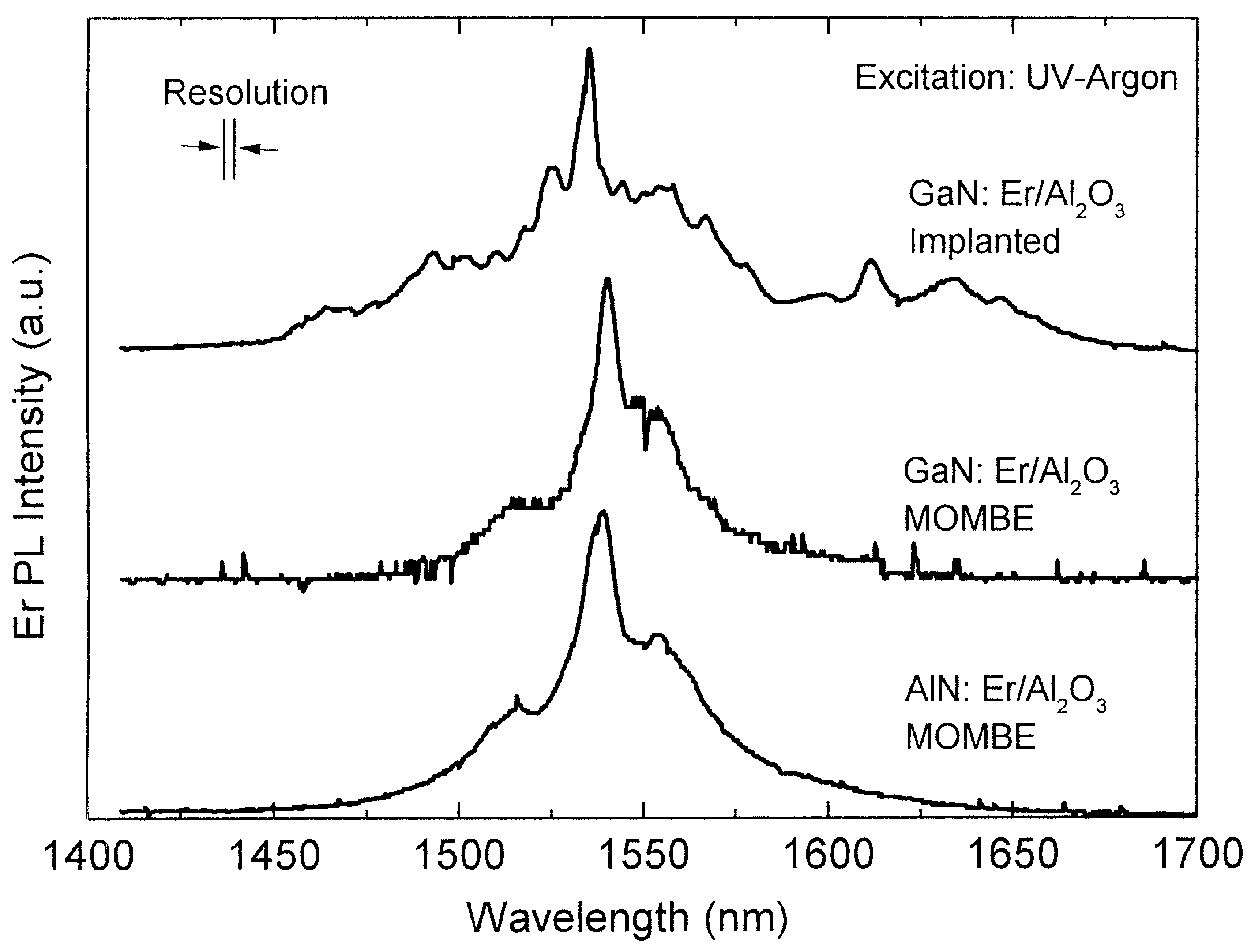Semiconductors doped with rare earth atoms have been studied for more than a decade because of the potential of using them to 31 develop compact and effificient electroluminescence (EL) devices. Trivalent erbium ions (Er ) are of special interest because they exhibit atomic-like transitions centered at 1540 nm, which corresponds to the low-loss window of silica-based optical fifibers. While EL devices, based on Er-doped Si and GaAs materials, have been fabricated, their effificiency remains too low for practical applications. Several years ago an important observation was made that there was less detrimental temperature quenching of Er luminescence intensity for larger bandgap host materials. Therefore, Er-doping of wide gap semiconductors, such as the III–V nitrides, appears to be a promising approach to overcoming the thermal quenching of Er luminescence found in Si and GaAs. In particular, GaN epilayers doped with Er ions have shown a highly reduced thermal quenching of the intensity of the Er luminescence from cryogenic to elevated temperatures. The remarkable thermal stability of the light emission may be due to the large energy bandgap of the material, as well as to the optical inactivity of the material defects in the GaN fifilms. In this paper, recent data concerning the luminescence characteristics of Er-doped GaN thin fifilms are presented. Two different methods have been used for Er-doping of the GaN fifilms: ion implantation and in situ doping 31 during epitaxial growth. Both methods have proven successful for incorporation and optical activation of Er ions. Infrared photoluminescence spectra, centered at 1540 nm, have been measured for various Er-doped III–N fifilms. Considerably different emission spectra, with different thermal quenching characteristics, have been observed, depending upon the wavelength of the optical pump and the Er-doping method. Defect-related absorption centers permit excitation of the Er ions using below-bandgap optical sources. Elemental impurities, such as O and C, in the thin fifilms have also been shown to inflfluence the emission spectra and to lead to different optical characteristics. 2000 Published by Elsevier Science S.A. All rights reserved.
The optical properties of rare earth ions in insulatingmaterials have been extensively studied for applications insolid-state lasers and optical fiber amplifiers. Solid-state lasers, such as Nd3+:YAG, are based on the 4fintra-subshell transitions of the rare earth trivalent ions(RE'+) and exhibit a very stable lasing wavelength with aminimum temperature dependence. Because of thesecharacteristics, such lasers have found widespread applications in laboratory and military systems. Er-doped silicafibers are being used for amplification of optical signals inwavelength division multiplexing (WDM) communicationsystems operating at 1.54μm. Pr-doped fibers are being developed for similar optical amplification at 1.3μm.
Favennec et al. studied the dependence of the emissionintensity of the Er3+ions on the bandgap of the hostsemiconductor as a function of sample temperature Several different semiconductors, including Si, were im-planted with Er* ions and the emission intensity wasmeasured at different temperatures. It was found that thephotoluminescence (PL) intensity decreased at highertemperatures. This thermal quenching of the PL intensitywas more severe for the smaller bandgap materials, such asSi (1.12 eV) and GaAs (1.43 eV). The wider bandgapcompounds, such as ZnTe (2.26 eV) and Cds (2.42 eV)exhibited less temperature dependence.

Fig2(a)
In Fig. 3(a) are shown the high-resolution PL spectra at300 and 550 K of the sample excited by below-bandgapradiation. This excitation method corresponds to indirectexcitation of the Er3+ions through the broad, defect-related, absorption band. There were significant changes inthe PL spectrum between 300 and 550 K. In additiondepending upon the excitation method, different subsets ofEr3+ions are excited leading to distinct PL spectra, asshown in Figs. 2(a) and 3(a). The FWHM of the PIspectrum in Fig. 3(a) at 300 K was ~50 nm, which wasnarrower than that in Fig. 2(a). There was also a largechange in the integrated PL intensity over the range ofmeasurement temperatures, as indicated in Fig. 3(b)Relative to its value at 15 K, the integrated PL intensity at550 K decreased by about 50%. While this behavior is notas good as the data shown in Fig. 2(b), this reducedthermal quenching is still less than that reported from anyother Er-doped Ill-V semiconductor.
The authors would like to thank A. J. Steckl for the loanof the GaN:Er sample grown by MBE which permitted thePL experiments described in Fig. 6.
上一篇: 晶圆级封装制造工艺及应用进展
下一篇: 半导体晶片上电镀铜的方法